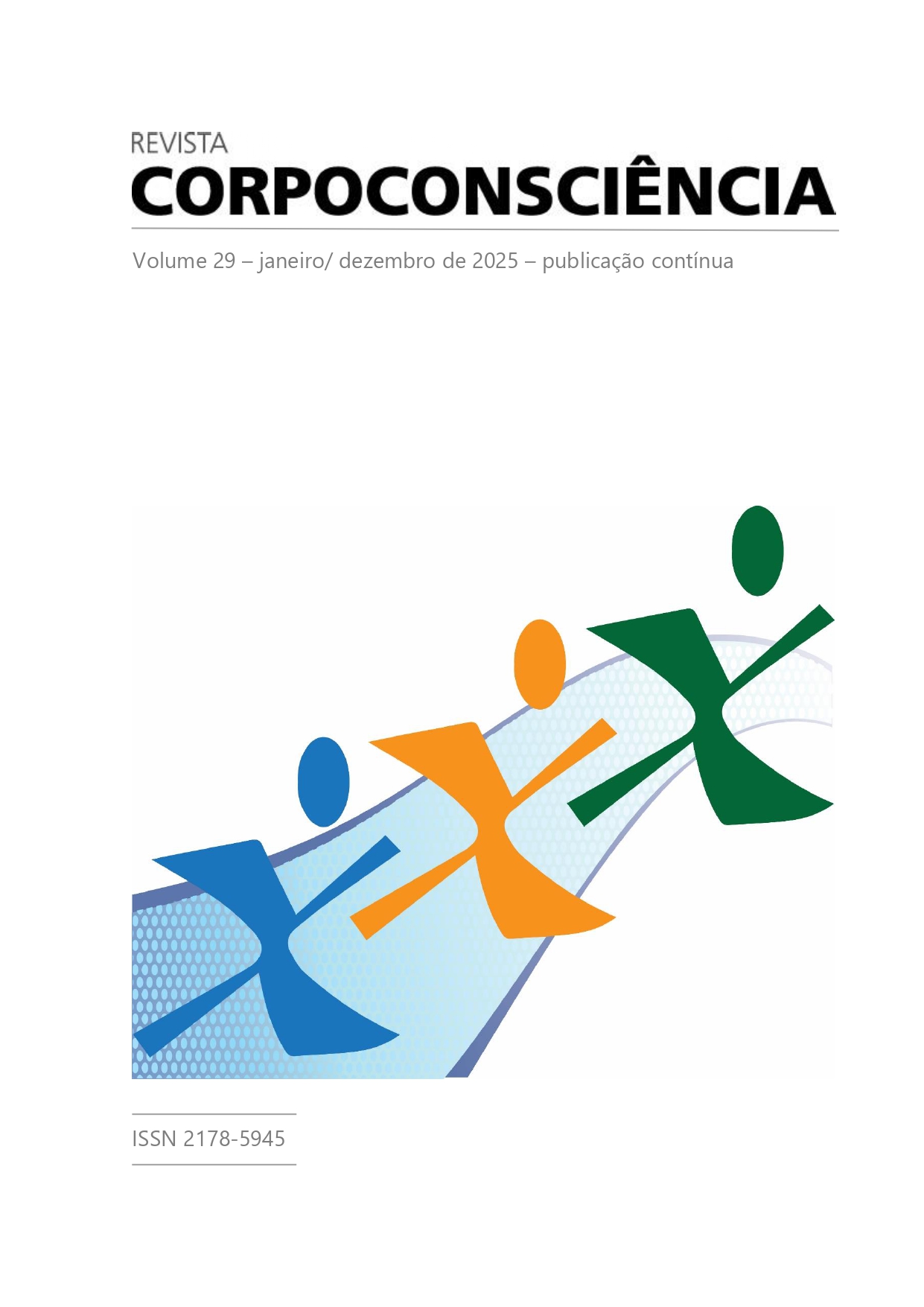TEMPO DE EXECUÇÃO DO CHUTE SEMICIRCULAR ESPORTIVO E TRADICIONAL (MAWASHI-GERI) NO KARATÊ SHOTOKAN
DOI:
https://doi.org/10.51283/rc.29.e18995Palavras-chave:
Artes Marciais, Esporte de Combate, Biomecânica, Análise CinemáticaResumo
Este estudo objetivou medir e comparar o tempo de execução dos estilos tradicional e esportivo do chute Mawashi-Geri em atletas de Karatê Shotokan. Dezesseis atletas (27,18±9,41 anos de idade, 15,19±6,87 anos de experiência) participaram do estudo. Cada atleta realizou seis chutes (três tradicionais e três esportivos) em ordem aleatória contra um Body Opponent Bag (BOB) fixo na altura da cintura, após um aquecimento padronizado. Os chutes foram filmados com uma câmera Casio™ EX-ZR100 (1920x1080, 30fps) e o tempo de execução foi analisado com o software Kinovea 0.8.15. Os resultados mostraram que o Mawashi-Geri esportivo apresentou um tempo de execução significativamente mais rápido (0,260 ± 0,040s) em comparação ao estilo tradicional (0,321±0,110s, p=0,016). Os achados sugerem que o estilo esportivo é mais eficaz para competições de Kumite (luta) devido à sua velocidade, enquanto o estilo tradicional pode ser mais adequado para práticas de Kihon (técnicas) e competições de Kata (formas).
Referências
CHANG, Wei-Gang et al. Differences in Pivot leg kinematics and electromyography activation in various round house kicking heights. Journal of sports science and medicine, v. 20, n. 3, p. 457-465, 2021.
CHANG, Ying-Chih et al. Sport activity for health!! The effects of karate participants’ involvement, perceived value, and leisure benefits on recommendation intention. International journal of environmental research and public health, v. 15, n. 5, p. 953, 2018.
DINIZ, Rossano et al. Kinematic comparison of the roundhouse kick between taekwondo, karate, and muaythai. Journal of strength and conditioning research, v. 35, n. 1, p. 198-204, 2021.
EMMERMACHER, Peter et al. Different variations of the Karate technique Mawashi-Geri. In: INTERNATIONAL SYMPOSIUM ON BIOMECHANICS IN SPORTS, 25, 2007. Proceedings… Federal University of Ouro Preto, Ouro Preto, SP.
IBÁÑEZ, Rafael et al. Observational analysis of the technical-tactical performance of elite karate contestants. Cultura, ciencia y deporte, v. 13, n. 37, p. 61-70, 2018.
JACKSON, Arthur S.; POLLOCK, Michael L. Generalized equations for predicting body density of men. British journal of nutrition, v. 40, n. 3, p. 497–504, 1978.
KAHROVIĆ, Izet Hamdo et al. Differences between Karate practitioners of varied competition orientations in specific motor tests results. Facta universitatis, v. 12, n. 3, p. 227–239, 2014.
LIANG, Ya-Dong. Technical statistics of female athletes at 3rd Wushu Sanda World Cup. Journal of wuhan institute of physical education, v. 41, n. 3, p. 89–96, 2007.
MANZENREITER, Wolfram. Karate - Bowing to the Olympics in style. In: HOLTHUS, Barbara et al. (Orgs.). Japan through the lens of the Tokyo Olympics. London, United Kingdom: Routledge, 2020.
MARQUES JUNIOR, Nelson Kautzner. Sugestão do Mawashi Geri do Karatê Shotokan com embasamento da biomecânica. Revista movimenta, v. 4, n. 1, p. 66–72, 2011.
OLIVEIRA, Leandro Marques de et al. Simetria intermembros no desempenho do chute Mae-Geri do karatê. Revista brasileira de ciência & movimento, v. 16, n. 4, p. 1–13, 2008.
OUERGUI, Ibrahim et al. Technical and tactical analysis of high level kickboxing matches. International journal of performance analysis in sport, v. 13, n. 2, p. 294-309, 2013.
PIEMONTEZ, George Roberts et al. Cinemática do chute semicircular no karatê: comparação entre as fases de ataque e retorno. Revista da educação física, v. 21, n. 1, p. 51-59, 2013.
VASCONCELOS, Breno Berny; DEL VECCHIO, Fabrício Boscolo. Wushu Sanda: color bias, home advantage and motor actions analysis in female matches’ from the 13th World Championships. Revista de artes marciales asiáticas, v. 12, n. 1, p. 1, 2017.
WORLD KARATE FEDERATION. Karate competition rules. 2020. Disponível em: <https://www.wkf.net/pdf/WKF_Competition Rules_2020_EN.pdf>. Acesso em: 2 nov. 2021.
Downloads
Publicado
Edição
Seção
Como Citar
Licença
Copyright (c) 2025 Corpoconsciência

Este trabalho está licenciado sob uma licença Creative Commons Attribution 4.0 International License.
Autores que publicam nesta revista concordam com os seguintes termos:
- Autores mantém os direitos autorais e concedem à revista o direito de primeira publicação, com o trabalho simultaneamente licenciado sob a Creative Commons Attribution License que permitindo o compartilhamento do trabalho com reconhecimento da autoria do trabalho e publicação inicial nesta revista.
-
A Revista Corpoconsciência da Universidade Federal de Mato Grosso está licenciada com uma Licença Creative Commons - Atribuição 4.0 Internacional. Baseado no trabalho disponível em https://periodicoscientificos.ufmt.br/ojs/index.php/corpoconsciencia/index.
- Autores têm autorização para assumir contratos adicionais separadamente, para distribuição não-exclusiva da versão do trabalho publicada nesta revista (ex.: publicar em repositório institucional ou como capítulo de livro), com reconhecimento de autoria e publicação inicial nesta revista.
- Autores têm permissão e são estimulados a publicar e distribuir seu trabalho online (ex.: em repositórios institucionais ou na sua página pessoal) a qualquer ponto antes ou durante o processo editorial, já que isso pode gerar alterações produtivas, bem como aumentar o impacto e a citação do trabalho publicado (Veja O Efeito do Acesso Livre).





